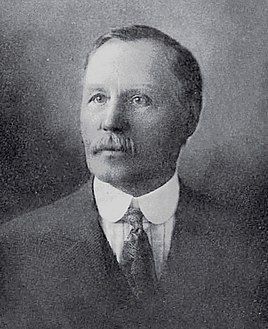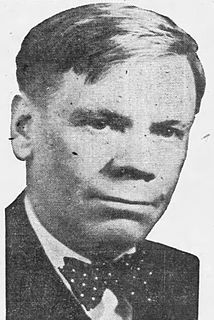
Marcus Aurelius "Mark" Smith was an American attorney and politician who served eight terms as Arizona Territorial Delegate to Congress and as one of the first two Senators from Arizona. As a Delegate he was a leader in the effort to gain statehood for Arizona. His non-voting status however minimized his influence with only 35 of the 277 bills he introduced into the House of Representatives being signed into law. Lack of a voice in the United States Senate further weakened his efforts as he managed to get Arizona statehood bills passed by the House only to see the legislation blocked in the Senate. Beyond his efforts for statehood, Smith worked to have government buildings constructed and to provide relief to his constituents affected by either man-made or natural misfortunes. His efforts to provide relief to the citizens of Arizona did not however extend to the indigenous population for whom Smith expressed great animosity.
The Constitution of the State of Arizona is the governing document and framework for the U.S. state of Arizona. The current constitution is the first and only adopted by the state of Arizona.

Richard Elihu Sloan was an American jurist and politician, who served as Associate Justice of the Arizona Territorial Supreme Court, a United States District Court judge and as the 17th and final Governor of Arizona Territory. As an Associate Justice he served for 16 years, the longest service of any member of the Arizona Territorial Supreme Court, and wrote over 150 legal opinions. As governor he oversaw Arizona's transition from territory to statehood.

The Presidency of William Howard Taft began on March 4, 1909, when William Howard Taft was inaugurated as President of the United States, and ended on March 4, 1913. Taft, a Republican, was the 27th United States president. The protégé and chosen successor of incumbent President Theodore Roosevelt, he took office after easily defeating Democrat William Jennings Bryan in the 1908 presidential election. His presidency ended with his defeat in the 1912 election by Democrat Woodrow Wilson.

Edmund William Wells was an American jurist, businessman, and politician. Known as "Arizona's first millionaire", he was considered the richest man in Arizona during his attempt to be elected Governor. He served as Attorney General for Arizona Territory before being appointed as a judge. He also served as a member of Arizona's constitutional convention.

The 1912 United States Senate elections took place on December 12, 1911 and March 27, 1912. This marked the first U.S. Senate elections held in Arizona after it was admitted to the union.

The 1914 Arizona gubernatorial election took place on November 3, 1914 for the post of the Governor of Arizona. The Supreme Court of Arizona ruled that there would be no statewide elections in 1912, thus extending the terms to sync up with elections on even years. The Democratic nominee was incumbent governor George W. P. Hunt, his Republican opponent was the final Delegate to Congress from Arizona Territory, Ralph H. Cameron. Cameron was disadvantaged by the same reason the previous Republican nominee Wells was: he had opposed statehood with the present Constitution.

The 1916 Arizona gubernatorial election took place on November 7, 1916 for the post of the Governor of Arizona. Due to battles between labor and business, the Hunt administration was facing severe electoral backlash. After facing a fairly strong primary by former Council member George Olney, Hunt prevailed and went on to face the closest election in Arizona gubernatorial history. The initial results of the 1916 election were extremely close, with Campbell winning by only 30 votes.

The 1918 Arizona gubernatorial election took place on November 5, 1918 for the post of the Governor of Arizona. Thomas Campbell, who served a partial term in 1917 and had his election overturned by the Supreme Court of Arizona, returned to contest the Governors office. Incumbent Governor Hunt declined to run again after the stress of the close elections and the year-long court battle. Despite falling to its lowest percentage in years, the sole third party challenger held the difference between the two candidates. The Democratic challenger was state senator Fred T. Colter, a pro-Hunt Democrat.

The 1922 Arizona gubernatorial election took place on November 7, 1922. George W. P. Hunt was Arizona's first governor, after retiring in 1919 he served as Ambassador to Siam during the tail end of the Wilson administration. After being dismissed by Harding, Hunt returned to Arizona and decided to contest his old seat. Both Hunt and Campbell faced off in 1916, the closest gubernatorial in Arizona history. This election was the highest percentage of votes Hunt ever got in his 7 gubernatorial races.

The 1924 Arizona gubernatorial election took place on November 4, 1924. Despite being a Republican year nationally, President Coolidge's election in Arizona was rather close. He only took Arizona with 40% of the vote against Davis' 35% and La Follette's 23%. The closest Arizona gubernatorial election since 1916, Hunt's lead in votes would continue to decline.

The 1926 Arizona gubernatorial election took place on November 2, 1926. Despite being a Democratic year generally, Hunt barely managed to be re-elected against his Republican opponent Elias Clark. Hunt had been governor for around 11 out of the State of Arizona's 14 years, coupled with his age and with issues regarding the Colorado River Compact, he was running out of steam. Despite that Hunt narrowly prevailed and won.

George Ulysses Young was an American businessman and politician. Active initially in railroads, he transitioned his business interests to mining. Politically he served as Secretary of Arizona Territory and as Mayor of Phoenix.

The 1928 Arizona gubernatorial election took place on November 6, 1928. Despite a fairly poor economy, a 15-point loss by Al Smith for the Arizona electoral votes, and having served for nearly 6 full terms, Hunt only narrowly lost the general election. Other state Democrats like Senator Ashurst and Representative Douglas both won re-election. John C. Phillips became the second Republican to serve as Arizona Governor, and the first to beat Hunt in a general election.

The 1930 Arizona gubernatorial election took place on November 4, 1930. George W. P. Hunt narrowly won the general election in 1930, defeating incumbent governor John Calhoun Phillips, who had defeated Hunt in his bid for reelection in the previous election year in 1928.

The 1932 Arizona gubernatorial election took place on November 8, 1932. Incumbent Governor George W. P. Hunt ran for the Democratic nomination, but lost in the primary to Benjamin Baker Moeur, whose pre-gubernatorial experience included service as the Secretary of the Board of Education for Arizona State Teacher's College, which would later become Arizona State University.

The 1934 Arizona gubernatorial election took place on November 6, 1934. Incumbent Governor Benjamin Baker Moeur ran for reelection, he was challenged by former governor George W. P. Hunt and future Governor Rawghlie Clement Stanford in the Democratic primary, but he defeated both of them by a comfortable margin.

Milton Speer "Mit" Simms, son of Maria Louisa Speer and Franklin Robert Simms, was born in Rockford, Alabama in 1873 and grew up there. He moved to Arizona Territory sometime before 1902. On December 25, 1902, he married his first wife, Lillian Mary McCabe (1881–1941). No children emerged from this marriage.

















